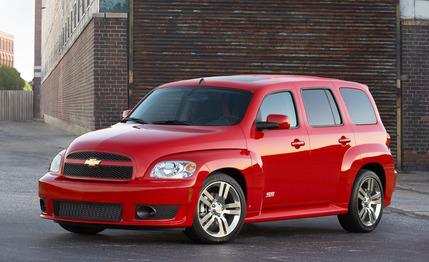 Review
Review
Introduction
The HHR is a stylish retro wagonette based on the Chevrolet Cobalt platform. Introduced in 2006, it offers more interior space and better looks than the Cobalt, although the roughly $3000 premium for the HHR is not insubstantial. An economy-minded ride, the regular HHR offers a choice of 2.2- and 2.4-liter four-cylinder engines, with 155 hp and 172 hp, respectively. Transmission choices are a five-speed manual and a four-speed automatic.
In 2008, Chevrolet added the HHR SS to the lineup. With a 2.0-liter turbocharged and direct-injected four-cylinder squeezing out 260 hp and 260 lb-ft of torque, the performance numbers this cutesy wagon generates will shut up plenty of naysayers. In addition to the powerful engine, the SS gets such hard-core features as launch control and a nifty no-lift shifting function for manual-transmission models that allows the driver to keep his foot planted on the gas during full-throttle acceleration. The transmission options are the same, although the five-speed is beefed up to handle the additional power, and choosing the automatic will cost you 10 hp and 37 lb-ft.
An HHR Panel is available as well, deleting the rear side windows and door handles for the old surfer-wagon look. You can also mix and match Panel and regular HHR, deleting the rear side windows but keeping the normal set of windowed rear doors. If you want solid rear doors, but windows in the rear, you’ll have to do some scrap-yard scrounging, because that combination is not available from the factory.
Verdict
Although Chevy claims the HHR is inspired by the 1949 Chevrolet Suburban, we think the styling was more inspired by the success of the Chrysler PT Cruiser. The look is, to put it nicely, derivative. Regardless, the HHR has a pleasant shape for something costing so little, and the seating position is nicely elevated. The interior, however, will remind you just how cheap the HHR is, as hard plastics and vast panel gaps abound.
The HHR Panel does a great job of capturing the 1950s surfer vibe, but utility is compromised by a bizarre plastic box inside conjured up to provide a flat load floor. Although it accomplishes this task, cargo volume is significantly less than it would have been if engineers had just removed the rear seat. It’s intended for those with small businesses, for which it makes a fetching mobile billboard, but they’d better not have any big items to carry.
The HHR SS is a surprisingly competent little machine: powerful, responsive, and easy on the eyes and ears. The short-throw five-speed feels crisp, the steering is tight, and the balance nearly on par with the best hot hatches on the road.
Click here for our full review of the Chevrolet HHR.
Click here for our full review of the Chevrolet HHR SS.
Click here for our latest comparison test involving the Chevrolet HHR.
What’s New for 2009
The HHR sees no major changes for 2009, but it does receive a number of minor updates. Both the 2.2- and 2.4-liter four-cylinders can now burn E85, and the 2.2 gets variable valve timing for a 6-hp boost in power and a 2-mpg bump in its highway fuel-economy rating. All models add a full complement of standard safety features, including stability and traction control, ABS, and curtain airbags. A backup camera—a boon on the low-visibility Panel models—and Bluetooth phone interface are optional.
Buyers can now get an HHR SS and Panel in one vehicle—the combination was previously unavailable—and a new SS Performance pack ($895) bundles the previously à la carte limited-slip differential and four-piston Brembo front brakes.
Highlights and Recommendations
The base HHR is the LS, which starts just under 20 grand and includes the 2.2-liter four, a five-speed manual, and all the safety equipment the HHR offers. Panel versions of the HHR add about a $300 premium.
Options on the LS are limited, and that model is only available with the smaller engine. It’s also the only way other than the SS to get a manual transmission with the HHR. Upgrading to the automatic transmission costs a grand and, as a bonus, includes a remote starter. Those who want an automatic HHR should start with the 2LT trim, which comes with the auto standard and is just $1000 more than an LS with the automatic. The 2LT also nets the more-powerful engine, which the HHR needs when equipped with only four gears.
Notable options include the Sun and Fun package, which is only available on 1LT models in sunny areas of the country, sadly. It includes a sunroof, a chrome grille, a roof spoiler, and 16-inch chrome wheels and costs about $2000. Those who don’t live in a sunny-enough clime can still get a chrome grille with the Bright Chrome package, which also splashes chrome onto the side-view mirrors, door handles, and 16-inch wheels. Interior improvements small and large are also available, with a Pioneer seven-speaker stereo fetching about $300 and dual headrest-mounted DVD screens going for around $1900.
The SS starts at more than $25,000; steep for an HHR, but fair for its competitive set and considering its capabilities. The Performance package is worthwhile, the $295 reconfigurable performance display is not.
Safety
For 2009, all versions of the HHR come standard with traction and stability control, anti-lock brakes, dual-stage driver and passenger airbags, curtain airbags, and tire-pressure monitoring.